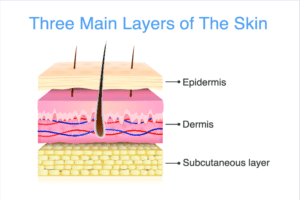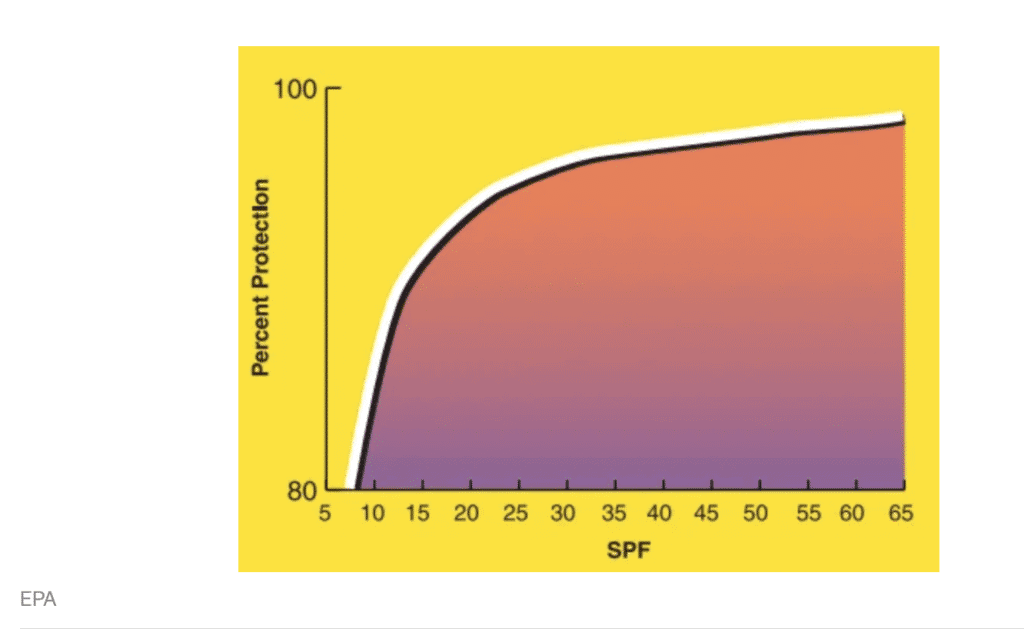It’s that time of year we are enjoying warmer weather and being outside. What about sunscreen? Skin damage is related to sunburns and prolonged sun exposure. We don’t often talk about the chemicals in the sunscreen we use and the adverse effects associated with them. Many of these chemicals are damaging to the environment and they are not safe for humans.
Solar radiation
Why do we use sunscreen? The goal is to filter solar radiation which is comprised of ultraviolet radiation (UVR), infrared, and high-energy visible light. The purpose of sunscreen is to protect us from UVR, which is just under 7% of the total solar radiation. UVR is comprised of UVA and UVB. UVA is 315-400nm in length, these are long-range, lower energy waves that penetrate the dermis. This can cause damage to the collagen leading to aging and tanning. UVB waves are 280-315 nm, these are short range, higher energy waves. These cause burning of the epidermis. Both of these waves can cause cancer, UVB by direct DNA damage and UVA by indirect damage by causing the formation of reactive oxygen species which damage DNA. The main cause of sunburn and non-melanoma skin cancer are due to UVB rays.

Sunscreen Safety
There are two types of sunscreen: mineral (nonsoluble) and chemical (soluble). The two main physical UV ingredients are zinc oxide and titanium dioxide. The minerals reflect the UV radiation and tend to appear white or opaque on the skin. These are the safest and highest-rated filters. Common chemical filters are avobenzone, oxybenzone, and octinoxate. These absorb some of the UV radiation and convert them to heating via chemical reactions. These products tend to be more “cosmetically pleasing” as they are not visible, but also provide inferior UV protection and require a combinations of chemicals.
“In particular, oxybenzone is a controversial sunscreen ingredient. It is a known endocrine disruptor, which is harmful, especially for pregnant women.
A 2018 study [1] showed that the use of Oxybenzone products during pregnancy caused severe damage to the mammary glands, which we know are of utmost importance to the health of your baby once they’re born. This intense effect on lactation could be harmful even as the mother is past the pregnancy and breastfeeding stage.
Further studies have shown that Oxybenzone can contaminate semen [2], placenta and breast milk of marine mammals and humans [3, 4] and is even linked to Hirschsprung’s disease, a development abnormality in humans in cases of prenatal exposure to Oxybenzone [5]. It is not recommended to use Oxybenzone-based products during pregnancy, breastfeeding, or on children under the age of 2.
For more information: Is it Safe to Wear Sunscreen While Pregnant?
Safe Options
“In 2019, when the federal Food and Drug Administration – the agency that governs sunscreen safety – proposed its most recent updates to sunscreen regulations, it found that only two ingredients, zinc oxide and titanium dioxide, could be classified as safe and effective, based on the currently available information. But in the past year, numerous new studies have raised new concerns about endocrine-disrupting effects from three other ingredients: homosalate, avobenzone and oxybenzone. The trouble with ingredients in sunscreens | EWG’s Guide to Sunscreens“
“In addition to sunscreen chemicals, scientists have identified several potential factors leading to coral reef damage, including elevated sea surface temperature and sewage and wastewater entering the ocean. The Truth About ‘Reef Safe’ Sunscreen“
SPF
In general, consumers choose products based on SPF rating, assuming accuracy and protection from harmful rays. SPF is an unreliable measure and often only reflects how well a product will protect from UVB rays. Another issue with SPF is that values above 50+ can give a false sense of security. Higher SPF rated products are more concentrated and ultilize a combination of chemicals.
“To calculate SPF, manufacturers compare skin slathered with sunscreen to skin without sunscreen and see how long each takes to redden. The relationship between SPF and sun protection does not increase linearly. As you can see here, the curve plateaus at about SPF 30:

SPF vs time
Here’s more, from the Environmental Protection Agency:
You should be aware that an SPF of 30 is not twice as protective as an SPF of 15; rather, when properly used, an SPF of 15 protects the skin from 93 percent of UVB radiation, and an SPF 30 sunscreen provides 97 percent protection”
Does sunscreen really prevent skin cancer? – Vox
SPF Accuracy
More on the accuracy of SPF ratings. “An EWG peer-reviewed study published in Photodermatology Photoimmunology and Photomedicine found a number of sunscreens sold in the U.S. provide inadequate UVA protection, compared to what the listed SPF would indicate, which gives sunscreen users a false sense of protection. A total of 51 sunscreen products were tested for UV-absorption in a laboratory using in vitro methodologies, and results showed that, on average, products reduced the UVA exposure by only half of what would be expected. Just 18 of 51 products passed the UVA protection test required of products sold in Europe. Given EWG’s findings, consumers should assume many sunscreen products on the market offer lower balanced UVA/UVB protection. We found the UVA protection factor was only a quarter of the labeled SPF, on average.
Most sunscreens tested by EWG also failed to show reliable UVB protection. Our research found that most sunscreens provided just 42 to 59 percent of the UVB protection that might reasonably be expected from the SPF label. U.S. sunscreens had higher labeled SPF values than tests would suggest, in addition to inadequate UVA protection, leaving consumers at potential risk for long-term harm from UV exposure.
Many products tested would not meet the UVA standards set by the European Commission for products sold in Europe. The European Commission recommends sunscreen products’ ratio of UVA protection to SPF be at least one-third. About a third of the products tested passed the EU standard, whereas more than nine out of 10 – 94 percent – would get the green light from the Food and Drug Administration.” More on this can be found here: The trouble with SPF | EWG’s Guide to Sunscreens.
Environment
There is information in the media about the impact of sunscreen on the environment and coral reefs. Hawaii has banned the use of sunscreens containing avobenzone and octinoxate.
“In addition to sunscreen chemicals, scientists have identified several potential factors leading to coral reef damage, including elevated sea surface temperature and sewage and wastewater entering the ocean. The Truth About ‘Reef Safe’ Sunscreen“
Other sun protection options
There are some things that you can do to avoid sun damage outside of sunscreen and sunblock. Avoiding midday sun is often helpful. Wearing hats, sunglasses, long sleeves/leggings, and sitting under an umbrella or in the shade.
Lots of things to think about when it comes to sunscreen. There are safe options and one reference that is helpful is from the Environmental Working Group (EWG) – Guide to Sunscreen


